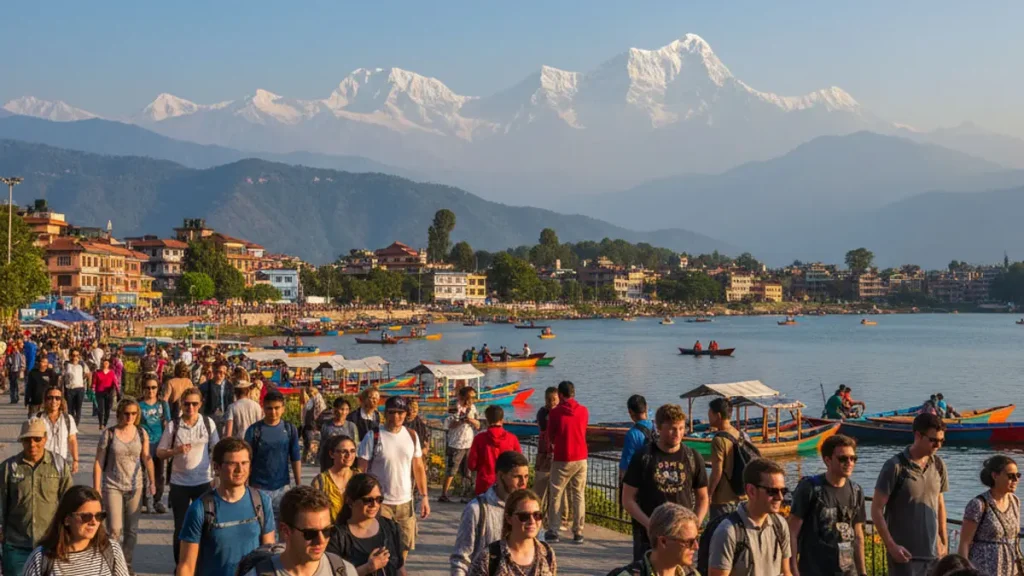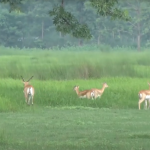
Pokhara’s tourism sector regains momentum as domestic and foreign visitors flock during festive holidays
Pokhara’s tourism industry, which had remained sluggish for some time, has seen a significant resurgence in recent weeks. The long Dashain–Tihar holidays, clear Himalayan views, and favorable weather have drawn large numbers of domestic and international tourists, creating a festive atmosphere across hotels, restaurants, and adventure sites. The surge has lifted the morale of local entrepreneurs and sent a positive signal throughout the tourism sector.
Tourism Rebounds with Clear Skies and Long Holidays
Known as one of Nepal’s premier tourist destinations, Pokhara offers panoramic views of the Annapurna range, the serene Phewa Lake, and a host of adventure sports such as paragliding, bungee jumping, and zip-flying. It also serves as the gateway to the Annapurna trekking circuit and Muktinath, attracting trekkers and pilgrims alike.
After a period of slowdown due to protests and unfavorable weather, Pokhara’s tourism has been revitalized by improved weather conditions and extended public holidays.
“Pokhara’s tourism sector, which has endured several setbacks, is finally seeing some relief,” said Laxman Subedi, President of the Hotel Association Pokhara.
“During Tihar, we are witnessing a satisfying mix of domestic and international visitors. The favorable weather and holidays have brought hotel occupancy in Lakeside to around 90 percent,” he added.
Subedi noted that the influx of tourists heading toward Annapurna, Mustang, and nearby destinations has boosted business across Gandaki Province.
According to him, the total investment in Pokhara’s tourism industry is around NPR 800 billion, of which NPR 600 billion is in the hotel sector alone. Approximately 15,000 people are directly employed in tourism-related businesses.
Hotels Nearly Fully Booked
There are about 1,200 tourist-standard hotels in Pokhara, with around 700 concentrated in the Lakeside and Damside areas. Combined, they can accommodate roughly 40,000 guests per night.
Currently, Pokhara hosts one five-star, six four-star, and around 30 three-, two-, and one-star luxury hotels.
Domestic tourists have also shown great enthusiasm for trekking. As a key gateway for trekking in Nepal, Pokhara serves as the starting point for several world-renowned routes, including the Annapurna Base Camp, Mardi Himal, and Ghorepani–Poon Hill treks. These trails attract thousands of trekkers every year, adding diversity to Pokhara’s tourism scene.
Trekking Activity on the Rise
“Pokhara is Nepal’s entry point for trekking,” said Krishna Acharya, President of the Trekking Agencies’ Association of Nepal (TAAN) Pokhara.
“The countless scenic trails in the Annapurna region have made it a global attraction for trekkers. We’re now seeing a healthy flow of both domestic and foreign tourists.”
Acharya urged the government to prioritize the preservation and promotion of trekking routes to ensure sustainable tourism.
“It’s natural for tourist numbers to rise during this season, but our goal is to keep trekking tourism active throughout the year,” he added.
TAAN has recently promoted the Annapurna North or Maurice Herzog Trail while identifying new routes, upgrading existing ones, and improving safety infrastructure and guide training.
According to recent data, between 1,000 and 1,200 foreign tourists and around 4,000 Nepali trekkers are entering the region daily through five major checkpoints—Chhomrong, Pothana, Birethanti, Besisahar, and Ghasa.
Restaurants and Bars See Strong Recovery
Bishwaraj Paudel, President of the Restaurant and Bar Association Nepal (REBAN) Pokhara, expressed happiness over the strong return of tourists.
“Compared to Dashain, the flow during Tihar has been excellent. Restaurants and bars are lively again, giving business owners renewed energy and optimism,” he said.
Calls for Long-Term Government Strategy
However, Hari Bhujel, Senior Vice President of the Pokhara Tourism Council, cautioned that the current seasonal surge is not enough to sustain long-term investments in the tourism sector.
“The government must develop a long-term plan to attract visitors year-round,” he said, emphasizing the need for strategic promotion of Pokhara’s natural beauty and cultural diversity in both domestic and international markets.
“Pokhara is a destination of natural, adventure, and cultural tourism. To elevate it further, strong coordination between the government and private sector is essential,” Bhujel added.
He also urged the state to adopt a sustainable tourism policy to protect the industry from the effects of natural disasters, political instability, and global crises. Developing Pokhara as an adventure tourism hub, identifying new destinations, and improving infrastructure should be national priorities, he said.
Destination of Diversity and Charm
From boating on Phewa Lake to sunrise viewing from Sarangkot, visits to the World Peace Pagoda, Davis Falls, Gupteshwor Cave, and the International Mountain Museum, Pokhara offers a rich blend of cultural and adventure experiences.
With the new Pokhara International Airport now in operation, the city is expected to see a significant rise in foreign arrivals.
Evenings around Phewa Lake have become vibrant, with cafes, restaurants, and shops creating a lively ambiance. Visitors enjoy boating, cycling, or walking along the lakeside, finding moments of tranquility and joy.
At the heart of the lake, the Tal Barahi Temple continues to hold deep spiritual and cultural significance for both locals and visitors.











